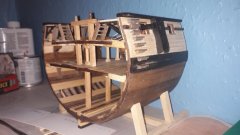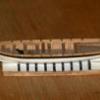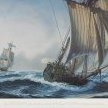MORE HANDBOOKS ARE ON THEIR WAY! We will let you know when they get here.
×
-
Posts
7,725 -
Joined
-
Last visited
Reputation Activity
-
 CDW got a reaction from FriedClams in Mikoyan-Gurevich MiG-15 by Danstream - FINISHED - Trumpeter - 1:48 - PLASTIC
CDW got a reaction from FriedClams in Mikoyan-Gurevich MiG-15 by Danstream - FINISHED - Trumpeter - 1:48 - PLASTIC
Beautiful model, very well done.
-
 CDW got a reaction from Edwardkenway in Mikoyan-Gurevich MiG-15 by Danstream - FINISHED - Trumpeter - 1:48 - PLASTIC
CDW got a reaction from Edwardkenway in Mikoyan-Gurevich MiG-15 by Danstream - FINISHED - Trumpeter - 1:48 - PLASTIC
Beautiful model, very well done.
-
 CDW got a reaction from popeye the sailor in Mikoyan-Gurevich MiG-15 by Danstream - FINISHED - Trumpeter - 1:48 - PLASTIC
CDW got a reaction from popeye the sailor in Mikoyan-Gurevich MiG-15 by Danstream - FINISHED - Trumpeter - 1:48 - PLASTIC
Beautiful model, very well done.
-
 CDW got a reaction from Old Collingwood in Mikoyan-Gurevich MiG-15 by Danstream - FINISHED - Trumpeter - 1:48 - PLASTIC
CDW got a reaction from Old Collingwood in Mikoyan-Gurevich MiG-15 by Danstream - FINISHED - Trumpeter - 1:48 - PLASTIC
Beautiful model, very well done.
-
 CDW got a reaction from Danstream in Mikoyan-Gurevich MiG-15 by Danstream - FINISHED - Trumpeter - 1:48 - PLASTIC
CDW got a reaction from Danstream in Mikoyan-Gurevich MiG-15 by Danstream - FINISHED - Trumpeter - 1:48 - PLASTIC
Beautiful model, very well done.
-
 CDW reacted to Danstream in Mikoyan-Gurevich MiG-15 by Danstream - FINISHED - Trumpeter - 1:48 - PLASTIC
CDW reacted to Danstream in Mikoyan-Gurevich MiG-15 by Danstream - FINISHED - Trumpeter - 1:48 - PLASTIC
Mikoyan-Gurevich MIG 15 Bis
Red 40 - Nikolay Shkodin, 1953
(Trumpeter 1:48)
Hereinafter the pictures of my completed model of this Soviet fighter. The build presented few fitting issues, but at the end I am pleased with the result. I chose not to install the jet engine inside the rear fuselage and to display it next to the aircraft. I used aftermarket seatbelt, instrument panel and resin main wheels for increased detailing.
The Jet engine Klimov-vk1 is fairly reproduced for this scale and, as said, I display it on a scratch build static stand.
The model was finished with Tamiya acrylic colors mixes and Vallejo metallic for the metallic finished parts. I tried the camouflage bands by spraying them free-hand to obtain feathered demarcations. However, perhaps the effect that I obtained is a bit out of scale.
I obtained the 2 x 23 mm gun muzzles by aluminium tubes, while the muzzle of the 37 mm cannon is an Eduard replacement.
I modified the oversimplified pilot seat to better reproduce the type used at the time of this aircraft.
The panel lines were obtained by oil colors washes. Other small stains were made with watercolor pencils.
I found this aircraft rather interesting to build and I hope you like my final pictures. The complete build log is reported in the above pages. I would like to thanks all those that followed my long build and especially those that have provided comments and suggestions.
Best regards,
Dan
-
 CDW reacted to Kevin in SD14 Stern Section by Kevin - Marcle Models - 1/70 - CARD - started 1st Jan 2022 - abandoned
CDW reacted to Kevin in SD14 Stern Section by Kevin - Marcle Models - 1/70 - CARD - started 1st Jan 2022 - abandoned
good evening everyone
well thats the double bottom floors in, they will now all be removed to ensure they fit properly, and most likely get a Modge Podge varnish on them as i would like to show some access to them, might just be an open tank top or go the whole hog and open one up to show a feed water tank to oil fuel tank, and if thats the case i need the varnish to allow some painting to take place
then before the tank tops go into position all the Longitudinals need to be fitted
no glue has yet been used,
these go in next, which ensure everything is square
all the folds against the centre line need to be trimmed back to avoid the bunching
-
 CDW got a reaction from mtaylor in HMS Hood by Old Collingwood - Flyhawk - 1/700 - PLASTIC - After her explosion.
CDW got a reaction from mtaylor in HMS Hood by Old Collingwood - Flyhawk - 1/700 - PLASTIC - After her explosion.
Be sure to let us know how that glue works out for you.
-
 CDW got a reaction from king derelict in HMS Hood by Old Collingwood - Flyhawk - 1/700 - PLASTIC - After her explosion.
CDW got a reaction from king derelict in HMS Hood by Old Collingwood - Flyhawk - 1/700 - PLASTIC - After her explosion.
Be sure to let us know how that glue works out for you.
-
 CDW reacted to reklein in USS Missouri by reklein - Sterling - 1/192 Scale
CDW reacted to reklein in USS Missouri by reklein - Sterling - 1/192 Scale
further progress on the Missouri. The second photo shows how I made the 5" mounts positionable.
-
 CDW got a reaction from Canute in HMS Hood by Old Collingwood - Flyhawk - 1/700 - PLASTIC - After her explosion.
CDW got a reaction from Canute in HMS Hood by Old Collingwood - Flyhawk - 1/700 - PLASTIC - After her explosion.
Be sure to let us know how that glue works out for you.
-
 CDW got a reaction from Canute in HMS Hood by Old Collingwood - Flyhawk - 1/700 - PLASTIC - After her explosion.
CDW got a reaction from Canute in HMS Hood by Old Collingwood - Flyhawk - 1/700 - PLASTIC - After her explosion.
He said in an earlier post he was giving up on the railings...too small.
(I will be honest and say at this scale the railings are beyond me and I do not have the full set now anyway - so I am going to build her minus the railings.
OC.)
-
 CDW reacted to Old Collingwood in HMS Hood by Old Collingwood - Flyhawk - 1/700 - PLASTIC - After her explosion.
CDW reacted to Old Collingwood in HMS Hood by Old Collingwood - Flyhawk - 1/700 - PLASTIC - After her explosion.
Craig just incase I came across confusing - in the kit there are Two large sheets of PE Sheet 1 contains the correct size rails for the Weather Deck and superstructure, apart from a few peices I fitted earlier to the superstructer, this is the sheet that I have managed ot damage the rails on, there is another sheet - sheet2 this contains the main deck forward and aft rail aswel as a few others that I can not find thier intended use as it does not list them on the PE instructions.
I was seriously put off with how difficult and delicate these are, but after finding a better gluing option and ordering it, its kind of given me a second wind - so I will re check my other PE sheet to find out what is spare to do the 12 (6 each side) sections of railing on the weather deck.
OC.
-
 CDW got a reaction from Landlubber Mike in HMS Hood by Old Collingwood - Flyhawk - 1/700 - PLASTIC - After her explosion.
CDW got a reaction from Landlubber Mike in HMS Hood by Old Collingwood - Flyhawk - 1/700 - PLASTIC - After her explosion.
He said in an earlier post he was giving up on the railings...too small.
(I will be honest and say at this scale the railings are beyond me and I do not have the full set now anyway - so I am going to build her minus the railings.
OC.)
-
 CDW got a reaction from mtaylor in HMS Hood by Old Collingwood - Flyhawk - 1/700 - PLASTIC - After her explosion.
CDW got a reaction from mtaylor in HMS Hood by Old Collingwood - Flyhawk - 1/700 - PLASTIC - After her explosion.
He said in an earlier post he was giving up on the railings...too small.
(I will be honest and say at this scale the railings are beyond me and I do not have the full set now anyway - so I am going to build her minus the railings.
OC.)
-
 CDW got a reaction from Landlubber Mike in HMS Hood by Old Collingwood - Flyhawk - 1/700 - PLASTIC - After her explosion.
CDW got a reaction from Landlubber Mike in HMS Hood by Old Collingwood - Flyhawk - 1/700 - PLASTIC - After her explosion.
An airbrush requires lots of practice to become proficient with it. Lots and lots of practice. This practice includes varying dilutions of paint to thinner ratios, air pressure, and distance from the tip of the airbrush to the thing being painted. An airbrush such as the one you own is meant to be a very precise way of applying paint. Once it's been mastered, applying very thin layers of paint precisely where it's needed will be a breeze. But there is a learning curve that only comes with time and practice. Painting a line not much wider than a pencil line will be possible with the equipment you own.
Another area of expertise that requires practice is finding various ways of masking off the areas where you don't want paint from errant airbrush use. Lots of times this can be done by simply using a stiff sheet of paper to shield the areas to be protected. it doesn't always require masking tape.
All that being said, the most desirable way to paint the photo etch railings (in my opinion) is to paint them after they have been attached in place. This is not always possible, but many times it can be done quite readily. When painting them before assembly, doing it with the airbrush while attached to the photo etch fret is the next best option. Yes, you may get some cracking and peeling of the paint when you bend the rails later on, but it's a breeze to touch up those places with a brush after the fact.
You're working at a scale that makes your debut into airbrushing much more challenging. Don't get discouraged, just make it a habit to practice a bit with your airbrush every chance you get, and don't practice on your best models 🙂. Practice on paper or old models. I've seen Flory use the same model to practice on for years. He calls the model, "Buster". 😄
-
 CDW reacted to Canute in HMS Hood by Old Collingwood - Flyhawk - 1/700 - PLASTIC - After her explosion.
CDW reacted to Canute in HMS Hood by Old Collingwood - Flyhawk - 1/700 - PLASTIC - After her explosion.
OC, I think Gator Grip glue is available, but you need to email Kenny to get it.
I'll second Alan's recommendation for using it. I apply the regular (thicker) with a paint brush. I keep a cup of water handy to clean the brush. And I let it tack up for a minute or so. Parts seem to stick well.
-
 CDW got a reaction from Canute in HMS Hood by Old Collingwood - Flyhawk - 1/700 - PLASTIC - After her explosion.
CDW got a reaction from Canute in HMS Hood by Old Collingwood - Flyhawk - 1/700 - PLASTIC - After her explosion.
An airbrush requires lots of practice to become proficient with it. Lots and lots of practice. This practice includes varying dilutions of paint to thinner ratios, air pressure, and distance from the tip of the airbrush to the thing being painted. An airbrush such as the one you own is meant to be a very precise way of applying paint. Once it's been mastered, applying very thin layers of paint precisely where it's needed will be a breeze. But there is a learning curve that only comes with time and practice. Painting a line not much wider than a pencil line will be possible with the equipment you own.
Another area of expertise that requires practice is finding various ways of masking off the areas where you don't want paint from errant airbrush use. Lots of times this can be done by simply using a stiff sheet of paper to shield the areas to be protected. it doesn't always require masking tape.
All that being said, the most desirable way to paint the photo etch railings (in my opinion) is to paint them after they have been attached in place. This is not always possible, but many times it can be done quite readily. When painting them before assembly, doing it with the airbrush while attached to the photo etch fret is the next best option. Yes, you may get some cracking and peeling of the paint when you bend the rails later on, but it's a breeze to touch up those places with a brush after the fact.
You're working at a scale that makes your debut into airbrushing much more challenging. Don't get discouraged, just make it a habit to practice a bit with your airbrush every chance you get, and don't practice on your best models 🙂. Practice on paper or old models. I've seen Flory use the same model to practice on for years. He calls the model, "Buster". 😄
-
 CDW got a reaction from mikegr in HMS Hood by Old Collingwood - Flyhawk - 1/700 - PLASTIC - After her explosion.
CDW got a reaction from mikegr in HMS Hood by Old Collingwood - Flyhawk - 1/700 - PLASTIC - After her explosion.
An airbrush requires lots of practice to become proficient with it. Lots and lots of practice. This practice includes varying dilutions of paint to thinner ratios, air pressure, and distance from the tip of the airbrush to the thing being painted. An airbrush such as the one you own is meant to be a very precise way of applying paint. Once it's been mastered, applying very thin layers of paint precisely where it's needed will be a breeze. But there is a learning curve that only comes with time and practice. Painting a line not much wider than a pencil line will be possible with the equipment you own.
Another area of expertise that requires practice is finding various ways of masking off the areas where you don't want paint from errant airbrush use. Lots of times this can be done by simply using a stiff sheet of paper to shield the areas to be protected. it doesn't always require masking tape.
All that being said, the most desirable way to paint the photo etch railings (in my opinion) is to paint them after they have been attached in place. This is not always possible, but many times it can be done quite readily. When painting them before assembly, doing it with the airbrush while attached to the photo etch fret is the next best option. Yes, you may get some cracking and peeling of the paint when you bend the rails later on, but it's a breeze to touch up those places with a brush after the fact.
You're working at a scale that makes your debut into airbrushing much more challenging. Don't get discouraged, just make it a habit to practice a bit with your airbrush every chance you get, and don't practice on your best models 🙂. Practice on paper or old models. I've seen Flory use the same model to practice on for years. He calls the model, "Buster". 😄
-
 CDW got a reaction from mtaylor in HMS Hood by Old Collingwood - Flyhawk - 1/700 - PLASTIC - After her explosion.
CDW got a reaction from mtaylor in HMS Hood by Old Collingwood - Flyhawk - 1/700 - PLASTIC - After her explosion.
An airbrush requires lots of practice to become proficient with it. Lots and lots of practice. This practice includes varying dilutions of paint to thinner ratios, air pressure, and distance from the tip of the airbrush to the thing being painted. An airbrush such as the one you own is meant to be a very precise way of applying paint. Once it's been mastered, applying very thin layers of paint precisely where it's needed will be a breeze. But there is a learning curve that only comes with time and practice. Painting a line not much wider than a pencil line will be possible with the equipment you own.
Another area of expertise that requires practice is finding various ways of masking off the areas where you don't want paint from errant airbrush use. Lots of times this can be done by simply using a stiff sheet of paper to shield the areas to be protected. it doesn't always require masking tape.
All that being said, the most desirable way to paint the photo etch railings (in my opinion) is to paint them after they have been attached in place. This is not always possible, but many times it can be done quite readily. When painting them before assembly, doing it with the airbrush while attached to the photo etch fret is the next best option. Yes, you may get some cracking and peeling of the paint when you bend the rails later on, but it's a breeze to touch up those places with a brush after the fact.
You're working at a scale that makes your debut into airbrushing much more challenging. Don't get discouraged, just make it a habit to practice a bit with your airbrush every chance you get, and don't practice on your best models 🙂. Practice on paper or old models. I've seen Flory use the same model to practice on for years. He calls the model, "Buster". 😄
-
 CDW reacted to Old Collingwood in HMS Hood by Old Collingwood - Flyhawk - 1/700 - PLASTIC - After her explosion.
CDW reacted to Old Collingwood in HMS Hood by Old Collingwood - Flyhawk - 1/700 - PLASTIC - After her explosion.
Evening all, bit more progress (not sure you can call it that) I decided to have a go at priming my pieces of railing I wanted to use - so I applied it with my brush, I put a few light coats on drying between, anyway I noticed the whole fret had stuck to my mat - gently trying to free it - Yep it broke most of the rails with only a few intact (bent but usable) so I went a head a cut them away but most of the paint had stuck to the mat and not the rails, so I decided to scrape off the worst back to metal and try to fit Two sections small with a centre bend, they went down kind of Ok, then I tried Two slightly longer ssections (not massive long) but how ever many times I tried to fit them - no good.
I will be honest and say at this scale the railings are beyond me and I do not have the full set now anyway - so I am going to build her minus the railings.
OC.
-
 CDW got a reaction from lmagna in HMS Hood by Old Collingwood - Flyhawk - 1/700 - PLASTIC - After her explosion.
CDW got a reaction from lmagna in HMS Hood by Old Collingwood - Flyhawk - 1/700 - PLASTIC - After her explosion.
Merry Christmas OC
-
 CDW reacted to hof00 in Bismarck by hof00 - FINISHED - Amati - 1/200 - Partworks
CDW reacted to hof00 in Bismarck by hof00 - FINISHED - Amati - 1/200 - Partworks
Hi All,
Small Update:
Started cladding the first tier of the Aft Superstructure.
I think it went o.k. and the epoxy is still going off. (Used 90 second epoxy as gives more time than the recommended CA)
A bit of work to do before I'm happy with it but getting there.... (Tomorrow's work.)
A bonus is that the Deck still fits!! 🙂
Cheers....HOF.
Photos:
-
 CDW reacted to hof00 in Bismarck by hof00 - FINISHED - Amati - 1/200 - Partworks
CDW reacted to hof00 in Bismarck by hof00 - FINISHED - Amati - 1/200 - Partworks
Hi All,
Small update....
Completed Aft Gunnery Control Thingy and Anti Aircraft Gunnery stations.
I am finding out more about PE and had to form Railings for the first time. (Not too bad with 1.5 arms.... 😗)
Not particularly happy about the joint where the Railings meet to form a circle, They are o.k. but will have a think about improvements, perhaps.... It may be better to leave well alone.
Looking at sizing, (Ensuring Deck edges are flush with Superstructure sides), the 1st tier Superstructure Decking.
I think this will be tomorrow.
I might even get some PE sides attached!! 🙂
Thank you for all the "Likes!!"
Cheers....HOF.
Photos:
-
 CDW got a reaction from Landlubber Mike in De Havilland DH.82A Tiger Moth by ccoyle - FINISHED - Kartonowa Kolekcja - 1/33 - CARD - British two-seat trainer of 1931
CDW got a reaction from Landlubber Mike in De Havilland DH.82A Tiger Moth by ccoyle - FINISHED - Kartonowa Kolekcja - 1/33 - CARD - British two-seat trainer of 1931
Not much practical at all about a Ferrari, but man they are out of sight beautiful.

.jpg.7e80607770d9078b2f0b470e8c9c33ac.jpg)




.thumb.jpg.c459ce4140b54c12eddb8eedfd446df3.jpg)



